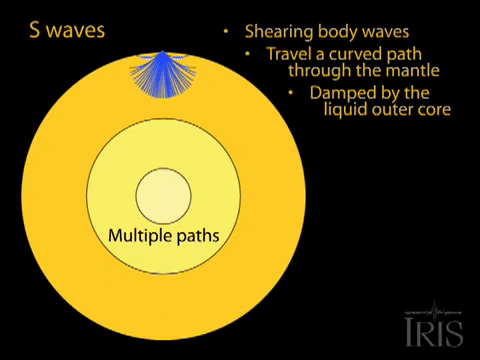SEISMOLOGY
The idea behind seismology is that the Earth (and other Terrestrial
planets) are like bells; when struck they ring. As a
consequence, if we disturb the Earth, for example, by dropping an asteroid
on it or by say, an earthquake, waves will be generated which
propagate through and around the Earth.
There are two kinds of waves which we will consider for this course:

The waves are defined by the direction in which the material is disturbed as
compared to the direction in which the wave propagates. For example,
- for the top picture, the
S(econdary) waves, the waves moves from
left-to-right, while the disturbance moves up and down (perpendicular to
the direction of wave propagation). This wave is like the disturbance you
would make if you snapped a whip or if you were to shake a rope.
These waves are also known as shear waves
or transverse waves.
- in the bottom picture, the
P(rimary) waves, the wave again moves from
left-to-right, while now the disturbance is in the same direction.
This wave is like a wave you make with a slinky (a spring). The spring
alternately compresses and expands with the coils of the spring moving in the
same direction in which the wave propagates. These waves are also known as
pressure waves or longitudinal waves.
P waves travel more quickly through the Earth than do
S waves. The
speed at which they move (and, in fact, whether they can propagate or not at
all) is determined by the properties of the material.
The P waves can travel through both liquid and solid material moving 5-6
km per second through the Earth while
S waves can only propagate through solid material moving at 3-4 km per
second through the Earth. S waves will not propagate
through liquid material.
So, people wait for an earthquake and then monitor
the arrival of the seismic waves, the
P and S waves.
Depending upon when the waves arrive and the type of wave which arrives, one
can deduce the interior structure of the Earth.



